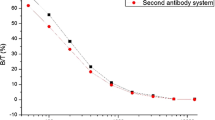Abstract
After the immunisation of rabbits with a psilocin-specific immunogen, polyclonal antisera were obtained. With these antisera a competitive, heterogeneous radioimmunoassay for the detection of psilocin was developed. As tracer a derivative of psilocin was synthesised, which contained a tritiated CH3 group. The antisera showed a specific reaction with psilocin. The cross-reactivity of structurally related endogenous substances like serotonin, tryptophan and tyrosine was below 0.01%. Also common drugs of abuse (Δ9-tetrahydrocannabinol, cocaine, morphine, amphetamine) showed negligible cross-reactivity (0.01–2%). Only tricyclic neuroleptics with a (dimethylamino)ethyl side-chain showed some cross-reactivity (20%). Spiked serum and blood samples were analysed with this new immunoassay and the results obtained were compared with the values measured with a validated GC-MS method.




Similar content being viewed by others
References
Passie T, Seifert J, Schneider U, Emrich HM (2002) The pharmacology of psilocybin. Addict Biol 7:357–364
Horita A, Weber LJ (1961) The enzymic dephosphorylation and oxidation of psilocybin and psilocin by mammalian tissue homogenates. Biochem Pharmacol 7:47–54
Horita A, Weber LJ (1962) Dephosphorylation of psilocybin in the intact mouse. Toxicol Appl Pharmacol 4:730–737
Kalberer F, Kreis W, Rutschmann J (1962) The fate of psilocin in the rat. Biochem Pharmacol 11:261–269
Hasler F, Bourquin D, Brenneisen R, Baer T, Vollenweider FX (1997) Determination of psilocin and 4-hydroxyindole-3-acetic acid in plasma by HPLC-ECD and pharmacokinetic profiles of oral and intravenous psilocybin in man. Pharma Acta Helv 72:175–184
Sticht G, Käferstein H (2000) Detection of psilocin in body fluids. Forensic Sci Int 113:403–407
Kysilka R (1990) Determination of psilocin in rat urine by high-performance liquid chromatography with electrochemical detection. J Chromatogr 534:287–290
Lindenblatt H, Kramer E, Holzmann-Erens P, Gouzoulis-Mayfrank E, Kovar K-A (1998) Quantitation of psilocin in human plasma by high-performance liquid chromatography and electrochemical detection: comparison of liquid-liquid extraction with automated online solid-phase extraction. J Chromatogr B Biomed Sci Appl 709:255–263
Grieshaber AF, Moore KA, Levine B (2001) The detection of psilocin in human urine. J Forensic Sci 46:627–630
Bogusz MJ (2000) Liquid chromatography-mass spectrometry as a routine method in forensic sciences: a proof of maturity. J Chromatogr B Biomed Sci Appl 748:3–19
Kamata T, Nishikawa M, Katagi M, Tsuchihashi H (2003) Optimized glucuronide hydrolysis for the detection of psilocin in human urine samples. J Chromatogr B Analyt Technol Biomed Life Sci 792:421–427
Sagawa K, Kimura A, Saito Y (2003) Production and characterization of a monoclonal antibody for sweat-specific protein and its application for sweat identification. Int J Legal Med 117:90–95
Pavlic M, Haidekker A, Grubwieser P (2002) Fatal accident caused by isoflurane abuse. Int J Legal Med 116:357–360
Albers C, Lehr M, Beike J, Kohler H, Brinkmann B (2002) Synthesis of a psilocin hapten and a protein-hapten conjugate. J Pharm Pharmacol 54:1265–1270
Nichols DE, Frescas S (1999) Improvements to the synthesis of psilocybin and a facile method for preparing the O-acetal prodrug of psilocin. Synthesis 6:935–938
Yamada F, Tamura M, Somei M (1998) A facile synthesis of psilocin from indole-3-carbaldehyde. Heterocycles 49:451–457
Abraham GE (1969) Solid phase radioimmunoassay of estradiol-17 beta. J Clin Endocrinol Metab 29:866–870
Troxler F, Seemann F, Hofmann A (1959) Synthetic indole compounds. II. Psilocybin and psilocin modifications. Helv Chim Acta 42:2073–2103
U.S. Department of Health and Human Services, Food and Drug Administration, Center for Drug Evaluation and Research, Medicine CfV (2001) Guidance for industry. Bioanalytical validation
Acknowledgement
The authors wish to thank Dr. W. Schneider and the staff from Dade Behring GmbH Marburg who were responsible for the animal experimental section.
Author information
Authors and Affiliations
Corresponding author
Rights and permissions
About this article
Cite this article
Albers, C., Köhler, H., Lehr, M. et al. Development of a psilocin immunoassay for serum and blood samples. Int J Legal Med 118, 326–331 (2004). https://doi.org/10.1007/s00414-004-0469-9
Received:
Accepted:
Published:
Issue Date:
DOI: https://doi.org/10.1007/s00414-004-0469-9




